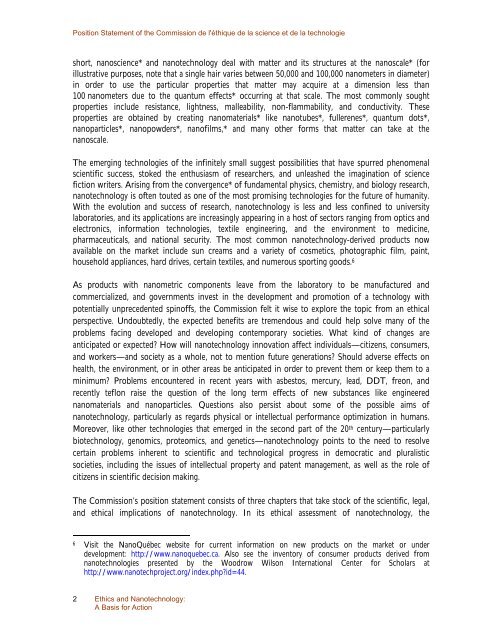A Basis for Action - Commission de l'éthique de la science et de la ...
A Basis for Action - Commission de l'éthique de la science et de la ...
A Basis for Action - Commission de l'éthique de la science et de la ...
You also want an ePaper? Increase the reach of your titles
YUMPU automatically turns print PDFs into web optimized ePapers that Google loves.
Position Statement of the <strong>Commission</strong> <strong>de</strong> l'éthique <strong>de</strong> <strong>la</strong> <strong>science</strong> <strong>et</strong> <strong>de</strong> <strong>la</strong> technologie<br />
short, nano<strong>science</strong>* and nanotechnology <strong>de</strong>al with matter and its structures at the nanoscale* (<strong>for</strong><br />
illustrative purposes, note that a single hair varies b<strong>et</strong>ween 50,000 and 100,000 nanom<strong>et</strong>ers in diam<strong>et</strong>er)<br />
in or<strong>de</strong>r to use the particu<strong>la</strong>r properties that matter may acquire at a dimension less than<br />
100 nanom<strong>et</strong>ers due to the quantum effects* occurring at that scale. The most commonly sought<br />
properties inclu<strong>de</strong> resistance, lightness, malleability, non-f<strong>la</strong>mmability, and conductivity. These<br />
properties are obtained by creating nanomaterials* like nanotubes*, fullerenes*, quantum dots*,<br />
nanoparticles*, nanopow<strong>de</strong>rs*, nanofilms,* and many other <strong>for</strong>ms that matter can take at the<br />
nanoscale.<br />
The emerging technologies of the infinitely small suggest possibilities that have spurred phenomenal<br />
scientific success, stoked the enthusiasm of researchers, and unleashed the imagination of <strong>science</strong><br />
fiction writers. Arising from the convergence* of fundamental physics, chemistry, and biology research,<br />
nanotechnology is often touted as one of the most promising technologies <strong>for</strong> the future of humanity.<br />
With the evolution and success of research, nanotechnology is less and less confined to university<br />
<strong>la</strong>boratories, and its applications are increasingly appearing in a host of sectors ranging from optics and<br />
electronics, in<strong>for</strong>mation technologies, textile engineering, and the environment to medicine,<br />
pharmaceuticals, and national security. The most common nanotechnology-<strong>de</strong>rived products now<br />
avai<strong>la</strong>ble on the mark<strong>et</strong> inclu<strong>de</strong> sun creams and a vari<strong>et</strong>y of cosm<strong>et</strong>ics, photographic film, paint,<br />
household appliances, hard drives, certain textiles, and numerous sporting goods. 6<br />
As products with nanom<strong>et</strong>ric components leave from the <strong>la</strong>boratory to be manufactured and<br />
commercialized, and governments invest in the <strong>de</strong>velopment and promotion of a technology with<br />
potentially unprece<strong>de</strong>nted spinoffs, the <strong>Commission</strong> felt it wise to explore the topic from an <strong>et</strong>hical<br />
perspective. Undoubtedly, the expected benefits are tremendous and could help solve many of the<br />
problems facing <strong>de</strong>veloped and <strong>de</strong>veloping contemporary soci<strong>et</strong>ies. What kind of changes are<br />
anticipated or expected? How will nanotechnology innovation affect individuals—citizens, consumers,<br />
and workers—and soci<strong>et</strong>y as a whole, not to mention future generations? Should adverse effects on<br />
health, the environment, or in other areas be anticipated in or<strong>de</strong>r to prevent them or keep them to a<br />
minimum? Problems encountered in recent years with asbestos, mercury, lead, DDT, freon, and<br />
recently teflon raise the question of the long term effects of new substances like engineered<br />
nanomaterials and nanoparticles. Questions also persist about some of the possible aims of<br />
nanotechnology, particu<strong>la</strong>rly as regards physical or intellectual per<strong>for</strong>mance optimization in humans.<br />
Moreover, like other technologies that emerged in the second part of the 20 th century—particu<strong>la</strong>rly<br />
biotechnology, genomics, proteomics, and gen<strong>et</strong>ics—nanotechnology points to the need to resolve<br />
certain problems inherent to scientific and technological progress in <strong>de</strong>mocratic and pluralistic<br />
soci<strong>et</strong>ies, including the issues of intellectual property and patent management, as well as the role of<br />
citizens in scientific <strong>de</strong>cision making.<br />
The <strong>Commission</strong>’s position statement consists of three chapters that take stock of the scientific, legal,<br />
and <strong>et</strong>hical implications of nanotechnology. In its <strong>et</strong>hical assessment of nanotechnology, the<br />
6 Visit the NanoQuébec website <strong>for</strong> current in<strong>for</strong>mation on new products on the mark<strong>et</strong> or un<strong>de</strong>r<br />
<strong>de</strong>velopment: http://www.nanoquebec.ca. Also see the inventory of consumer products <strong>de</strong>rived from<br />
nanotechnologies presented by the Woodrow Wilson International Center <strong>for</strong> Scho<strong>la</strong>rs at<br />
http://www.nanotechproject.org/in<strong>de</strong>x.php?id=44.<br />
2 Ethics and Nanotechnology:<br />
A <strong>Basis</strong> <strong>for</strong> <strong>Action</strong>
















